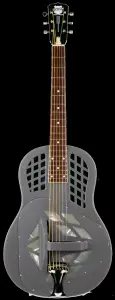JOHN DOPYERA (National Steel Guitar)
 It is impossible to picture Son House without a National Steel guitar in his hands. This iconic instrument was favoured by many Blues players for its loud ringing tone that could penetrate down the street or across a big room. In the days before amplification, a guitar that could penetrate across a noisy crowd was a big bonus and so, back in the day, National and Dobro resonator guitars were at the cutting edge of technology.
It is impossible to picture Son House without a National Steel guitar in his hands. This iconic instrument was favoured by many Blues players for its loud ringing tone that could penetrate down the street or across a big room. In the days before amplification, a guitar that could penetrate across a noisy crowd was a big bonus and so, back in the day, National and Dobro resonator guitars were at the cutting edge of technology.
Resonator guitars were invented by John Dopyera, who was born into a large family in Slovakia in 1893. John’s father Joseph was a gifted musician who made his own violins, which were famous around the country. Under his father’s guidance, John made violins too, but sensing the approach of WWI (their home in Dolna Krupa was only about 50 miles from Vienna), Joseph and his family emigrated to California. Arriving in LA, John set up a shop to make and repair violins and all kinds of stringed instruments. A local vaudeville promoter, George Beauchamp asked John to come up with a loud guitar to cut through the sound of the small orchestras at his shows. John’s solution was a metal guitar body with three aluminium cones under the bridge which picked up and amplified the vibration of the strings, causing the body of the guitar to act like a speaker cabinet. John and his brothers helped to set up the National Stringed Instrument Corp. in 1927. A single-cone resonator, or ‘biscuit’ design was developed and this and the original tri-cone design went on to sell in tens of thousands. The following year John and his brothers set up their own ‘Dobro’ company (a contraction of Dopyera Bros. which also translates in Slovak as ‘good’) to continue developing their resonator guitars with wooden bodies.
Son House’s unmistakable National sound on a Charley Patton track, ‘Prayer of Death’.

 The National Corporation, including Beauchamp, Adolph Rickenbacker and Paul Barth was more interested in experiments with electric guitars rather than resonators, coming up with their ‘Frying Pan’ aluminium design which went into limited production in 1932, and their future efforts were to expand in this direction. The Dobro guitar was a single resonator with an inverted, bowl-shaped cone which John patented separately from the patents owned by National. The resonator system could be made to work with a wooden body, so Dobro guitars could be made much cheaper than Nationals, but both had ornate Art-Deco designs on their resonators. By 1934 the brothers had regained control of National and merged the companies. They licensed the Regal company to expand production of their guitars, but all manufacture of resonators stopped when the USA joined WWII. Emil Dopyera re-started production in 1959, and ownership passed to Mosrite and OMI before being acquired by Gibson in 1993.
The National Corporation, including Beauchamp, Adolph Rickenbacker and Paul Barth was more interested in experiments with electric guitars rather than resonators, coming up with their ‘Frying Pan’ aluminium design which went into limited production in 1932, and their future efforts were to expand in this direction. The Dobro guitar was a single resonator with an inverted, bowl-shaped cone which John patented separately from the patents owned by National. The resonator system could be made to work with a wooden body, so Dobro guitars could be made much cheaper than Nationals, but both had ornate Art-Deco designs on their resonators. By 1934 the brothers had regained control of National and merged the companies. They licensed the Regal company to expand production of their guitars, but all manufacture of resonators stopped when the USA joined WWII. Emil Dopyera re-started production in 1959, and ownership passed to Mosrite and OMI before being acquired by Gibson in 1993.

Tampa Red used a tri-cone National Steel to record ‘Tight Like That’ with Georgia Tom in 1928, and the 1930 Charley Patton sessions had the unmistakable sound of Son House‘s resonator guitar. Even though John Dopyera had probably never heard any Blues music when he invented his guitar, his contribution to the sound of the Blues has been immense. From Delta originators like Bo Carter, through classic Bluesmen like Bukka White to modern players like Bob Brozman that penetrating tone has provided a distinctive and dynamic Blues voice.
Bob Brozman gives an original National Steel a workout;
Back in Slovakia, Dobrofest in Trnava is a week-long annual Festival of resonator guitar players from all over the world, that has been running for twenty years.
